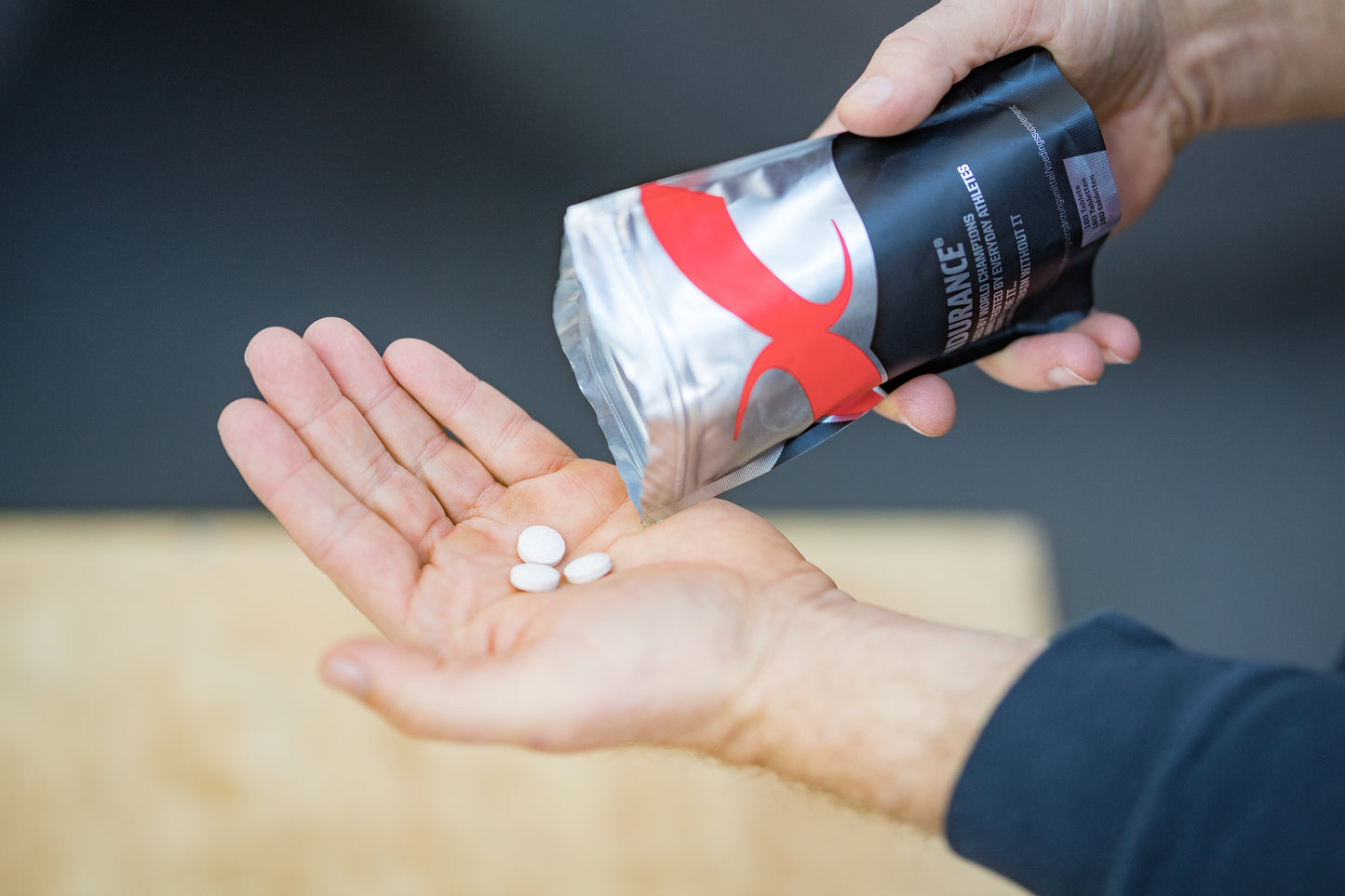Share
Lactic acid is a term often recognized by athletes, especially when they approach the final stretch of their race. Lactic acid buildup manifests as a distinct, burning pain in the calves or thighs, signaling an increase of lactic acid in the muscles. Such accumulation can hinder muscle performance, turning each subsequent stride into a more significant effort. For everyone from runners to cyclists, grasping the nuances of lactic acid and its impact on athletic performance is key to refining training methods and enhancing recovery.
What is Lactic Acid?
Lactic acid is an organic acid produced in our muscles and blood when the body breaks down carbohydrates under conditions of low oxygen (anaerobic metabolism). While it’s commonly blamed for the burning sensation during intense workouts, lactic acid itself isn’t the direct cause. Instead, it disassociates into lactate and hydrogen ions. It’s these hydrogen ions that lead to the drop in pH, causing the acidic environment responsible for muscle fatigue and pain.
What Causes Lactic Acid Buildup?
Lactic acid builds up when the oxygen supply doesn’t meet the demands of the muscles. This can happen during high-intensity activities when your body resorts to anaerobic metabolism to generate energy quickly. This energy system is efficient but produces lactic acid as a byproduct.
Symptoms of Lactic Acid Buildup
The primary symptom most associated with lactic acid is a burning sensation in the muscles during or after exercise. Other symptoms include:
- Muscle stiffness or cramps.
- Fatigue.
- Nausea (in severe cases).
Understanding Lactic Acid Formation During Exercise
When we engage in physical activity, our body primarily relies on oxygen to break down glucose and produce energy. This is a seamless process during moderate activities. However, during intense workouts, the oxygen supply might not meet the demand for energy production. In such situations, the body resorts to an alternative process, resulting in the production of a substance known as lactate. This lactate can be converted into energy even in the absence of oxygen. Yet, if the rate of lactate production surpasses its consumption, it starts accumulating in the bloodstream. This point of accumulation is termed the "lactate threshold."

Lactic Acid: Beyond Just Lactate
Lactic acid isn't just about lactate; it's a compound made of two ions - lactate and hydrogen. While lactate plays its part in energy production, it's the hydrogen ions that typically cause discomfort during strenuous activities. An excess of these hydrogen ions reduces the pH level in muscles, leading to the familiar burn and cramps that many of us associate with pushing our physical boundaries.
The Implications for Athletes
For athletes, understanding the balance of these ions is crucial. It's the hydrogen ions, being positively charged and acidic, that can hinder performance by causing pain and fatigue. If one could neutralise or counteract the effects of these ions, it might pave the way for longer training durations, heightened intensity, quicker recovery, and the ability for runners and other athletes to maintain higher paces over extended periods.
How Lactic Acid Affects Different Types of Athletes
1. Runners: Distance runners operate in an aerobic zone, but sprinters or those doing interval training frequently touch the anaerobic zone. That's why sprinters might feel the burn of lactic acid more intensely than marathon runners.
2. CrossFit Athletes: CrossFit involves high-intensity functional movements. These workouts often lead to significant lactic acid production due to their anaerobic nature.
3. Triathletes: These athletes combine swimming, cycling, and running. While the aerobic nature of these sports means less lactic acid buildup than in sprinting, pushing one's limits in any of the triathlon segments can cause a surge in lactic acid levels.
4. Cyclists: Like runners, cyclists can experience varying levels of lactic acid buildup based on intensity. A leisurely ride might produce minimal lactate, but a mountain climb or a time trial can lead to significant buildup.
Diet and Lactic Acid Buildup
Diet plays a crucial role in lactic acid production and clearance. Carbohydrates are the primary source of energy during high-intensity workouts. A diet low in carbohydrates can reduce the fuel available for anaerobic metabolism, which may impact performance.
Moreover, certain foods can aid in lactic acid clearance. For instance, foods rich in antioxidants (berries, nuts, green veggies) help combat oxidative stress from exercise and may assist in quicker lactate removal.
Hydration and Lactic Acid Buildup
Dehydration can reduce blood volume, making it harder for the body to remove lactic acid. Staying hydrated ensures efficient circulation, allowing for better lactic acid clearance from muscles and helping delay the onset of fatigue.
Reducing Lactic Acid
Here are some ways to manage and reduce lactic acid:
- Active Recovery: Gentle exercise post-intensity, like walking or slow jogging, can facilitate lactic acid clearance.
- Stretching: It helps in improving circulation and can assist in lactic acid removal.
- Massage: This can boost blood flow, aiding in faster lactate clearance.
- Hydration: Keeping hydrated helps in efficient lactic acid removal.
- Sleeping: 7 hours per night (more science to come on this)
The Role of Drinking Water in Lactic Acid Management
Drinking water plays a pivotal role in managing lactic acid levels during and post-exercise. When adequately hydrated, the blood maintains its optimal volume and circulation, facilitating the efficient transport and removal of lactic acid from the muscles. Furthermore, water aids in the dilution of lactate concentration in the bloodstream. Inadequate hydration can impede this process, leading to a slower clearance of lactic acid and potentially intensifying the associated muscle fatigue and discomfort. As such, maintaining proper hydration before, during, and after strenuous activities can be a simple yet effective strategy to mitigate the effects of lactic acid buildup, promoting faster recovery and better overall performance.
Lactic Acid Reduction in the Average Individual
For the average person not engaged in high-intensity athletic activities, the buildup and reduction of lactic acid might not be as pronounced as it is for athletes. However, managing and reducing lactic acid can still offer health benefits. Excess lactic acid can cause discomfort, muscle soreness, and fatigue even in everyday activities. By ensuring proper hydration, engaging in regular low-intensity exercises, and adopting practices like stretching, individuals can optimize lactic acid levels. This not only aids in overall muscle function but also promotes general well-being, reduces the risk of muscle cramps, and supports more efficient metabolic processes. In essence, while the everyday person might not grapple with lactic acid as athletes do, its proper management can still contribute to improved day-to-day muscular comfort and health.
Supplements and Lactic Acid
Certain supplements have been researched for their potential to reduce lactic acid buildup:
- Beta-Alanine: It's believed to help buffer the acid in muscles, potentially delaying fatigue. The negatives in using this ingredient to buffer lactic acid have been documented as skin rashes and paresthesia, a tingling sensation on the skin. It also takes 4-6 weeks for benefits to be noticeable.
- Bicarbonate Supplements: Can act as an extracellular buffer for the hydrogen ions produced during anaerobic metabolism. For those who take this ingredient, feeling thirsty, stomach cramps, and gas may be common symptoms.
- Lactic Acid Buffer: A sports nutrition supplement, extensively tested and proven to buffer the hydrogen ions and decrease damaging lactic acid build-up. The only effect mentioned when taking Lactic Acid Buffer is over-training. It is recommended to always manage rest days so as not to experience “burnout”.
The Critical Importance of Lactic Acid Management for Athletes
For athletes, lactic acid is not just a byproduct of exertion; it's a crucial determinant of performance, endurance, and recovery. The accumulation of lactic acid can mark the difference between achieving a personal best and facing muscle fatigue that hampers performance. It directly influences training intensity, recovery speed, and even the risk of injury. Properly managing its levels is essential to optimizing an athlete's potential and ensuring consistent progress in their chosen sport. While the everyday individual may not face the pronounced effects of lactic acid buildup as acutely as athletes, it's worth noting that they too can benefit from its effective management. Even for non-athletes, occasional attention to lactic acid can enhance everyday comfort and muscle functionality. In summary, while lactic acid management is paramount for athletes, it offers benefits to all, underscoring its universal relevance in physical health.









